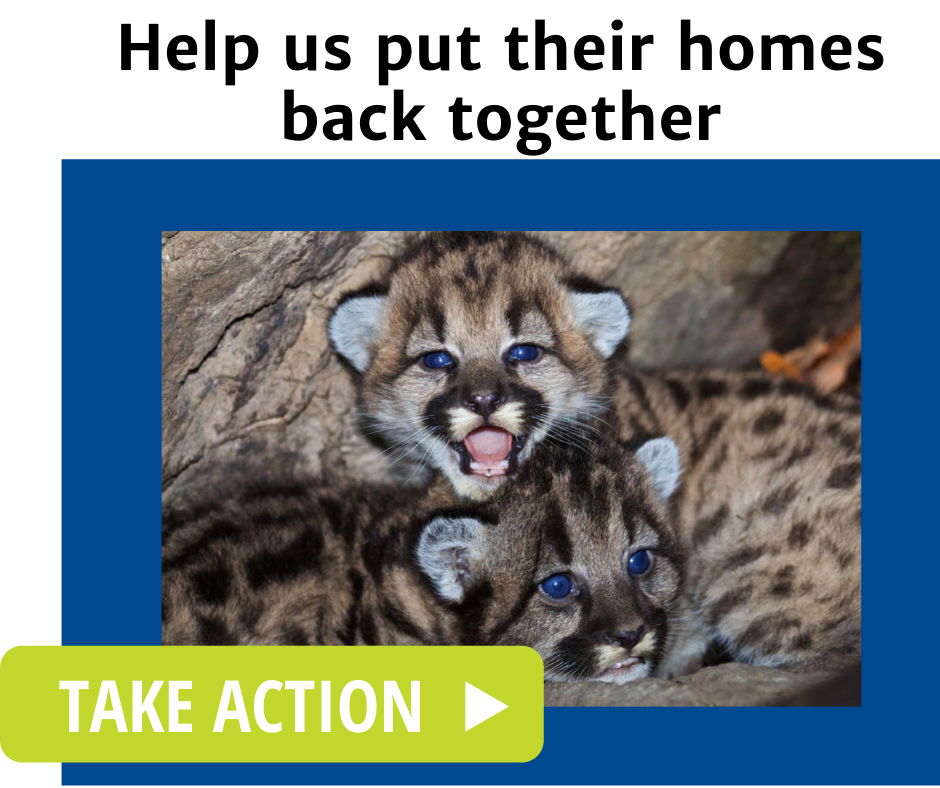

 |
Friend,
Mountain lion populations near Los Angeles could go extinct within the next 50 years.1
And freeways are partially to blame: Across the country, wildlife populations are suffering from habitats fractured by man-made infrastructure that isolates animals, blocks them from breeding, and could result in species dying out.2
If we want to keep our wildlife safe from extinction, we must make their homes whole again as best as we can. Tell Congress: It's time to support wildlife corridors.
When wildlife habitats are fractured by development, they don't just separate animals. Sometimes, they kill them: A survey showed that 21 Santa Monica mountain lions were struck and killed by vehicles as of 2019.3
But development threatens more than Los Angeles' mountain lions. An early study of wildlife fragmentation showed that development led to a 50 percent decline in affected bird species.4
Right now, we're in the middle of an extinction crisis -- species are disappearing at more than 100 times the natural rate.5 Our development has left wildlife with broken homes, but if we can stitch habitats back together, we can start to protect our most vulnerable species.
For example, a proposed wildlife corridor over a California highway would repair animals' habitat with a bridge that protects them from the more than 300,000 cars that travel on the freeway every day.6 But that's just one highway in a country with thousands.
The case for wildlife corridors couldn't be stronger. Will you join us in telling your U.S. House representative to support them?
When an animal's home is sliced in half by a highway, it loses access to critical food and breeding grounds. And if the only way to get back to the critical spaces is to cross a six-lane freeway, even a mountain lion doesn't stand a chance.
But it's not just wildlife overpasses. Wildlife corridors also include strips of land connecting two larger chunks of habitat, lowered fences, a series of ponds along the routes of migratory ducks, and more.
When we put animals' habitats back together, we take the first step toward building back their populations. Scientists in Tanzania and Brazil saw imperiled species' persistence time, or time until extinction in a region, increase by 56-fold once their habitat was restored.7
With fewer than than 5,000 mountain lions left in California, and other species across the country disappearing at alarming rates, the path forward is clear: We must reconnect their habitats.8
Help repair wildlife's fractured habitat.
Thank you,
Hannah Collazo
State Director
1. "Commission Votes In Favor Of Declaring SoCal Mountain Lions An Endangered Species," CBS Los Angeles, April 16, 2020.
2. "How is human behavior impacting wildlife movement?," Science Daily, January 29, 2021.
3. "Commission Votes In Favor Of Declaring SoCal Mountain Lions An Endangered Species," CBS Los Angeles, April 16, 2020.
4. Brad Plumer, "Stitching Together Forests Can Help Save Species, Study Finds," The New York Times, August 21, 2017.
5. Helen Briggs, "Extinction crisis 'poses existential threat to civilisation'," BBC News, June 2, 2020.
6. Katherine Gammon, "Los Angeles to build world's largest wildlife bridge across 10-lane freeway," The Guardian, August 21, 2019.
7. William D. Newmark, Clinton N. Jenkins, Stuart L. Pimm, Phoebe B. McNeally, and John M. Halley, "Targeted habitat restoration can reduce extinction rates in fragmented forests," Proceedings of the National Academy of Sciences of the United States of America, August 21, 2017.
8. Louis Sahagun, "Southern California mountain lions get temporary endangered species status," Los Angeles Times, April 16, 2020.
Donate today. A cleaner, greener future is within our reach. Your donation today can help us bring the vision we share a little closer to reality.
Environment Colorado, Inc.
1543 Wazee St., Suite 400, Denver, CO 80202, (303) 573-3871
Member questions or requests call 1-800-401-6511.
Facebook | Twitter
If you want us to stop sending you e-mail then follow this link -- Unsubscribe